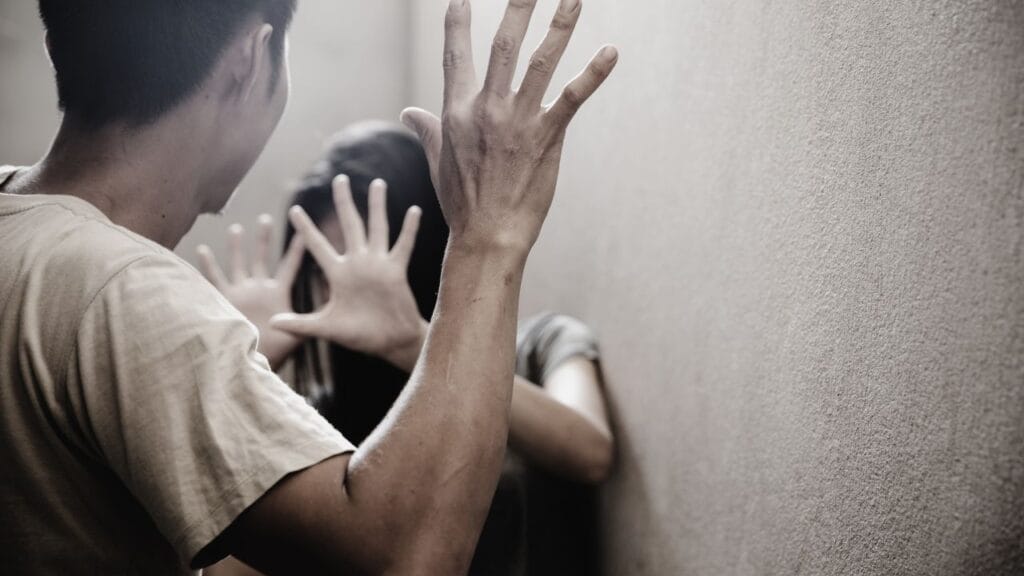Have you ever felt the suffocating weight of fear taking over your every thought and action? The relentless cycle of abuse, tearing at your spirit, leaving you feeling broken and desperate for an escape? Unfortunately, this is the reality that countless individuals face every day, trapped in the clutches of domestic violence.
Domestic abuse—a double-edged sword that cuts deep, leaving scars seen and unseen. For many, the aftermath is a battle fought on two fronts: the external fight for survival and the internal struggle against the lure of addiction. We dive into the stories of those who, in seeking a balm for their pain, find themselves grappling with the grip of drugs and alcohol.

But the impact of domestic violence doesn’t end there. It can reach deep into the core of a person’s being, leading to a devastating consequence: drug addiction. The connection between domestic violence and substance abuse is an unfortunate reality, where one trauma leads to another, creating a vicious cycle that seems impossible to break.
In this article, we will delve into the harrowing journey of survival, exploring how domestic violence and addiction intertwine. We will examine the different types of domestic violence, shed light on the alarming statistics surrounding this issue, and unveil the impact on mental health.
Most importantly, we will provide a glimmer of hope by exploring intervention strategies, recovery resources, and the importance of breaking the cycle of abuse. Because healing is possible, there is a path to reclaiming your life.
Join us as we uncover the hidden truths and embark on a journey of understanding, empathy, and resilience. Together, we can create a world free from the grip of domestic violence and addiction.
Key Takeaways:
- Domestic violence and addiction often coexist, with individuals who experience abuse more likely to develop a substance use disorder.
- Understanding the different types of domestic violence and recognizing the signs can help in addressing this issue.
- Survivors of domestic violence may turn to substance use as a coping mechanism for the trauma they have experienced.
- Intervention, support services, and dual diagnosis treatment are crucial in breaking the cycle of abuse and addiction.
- By challenging societal norms and promoting prevention initiatives, we can create a safer and more equitable future.
Types of Domestic Violence
Domestic violence manifests in various forms, each with its devastating effects on victims. Recognizing these types can help in identifying abuse and providing appropriate support. Below are the primary types of domestic violence, accompanied by brief examples or case studies:
- Physical Abuse: This type of abuse involves any act of violence that causes physical harm to the victim. For example, a case study might describe a person who has been repeatedly hit, kicked, or burned by their partner, resulting in visible injuries and scars.
- Sexual Abuse: Sexual abuse includes any non-consensual sexual act or behavior. A case study could involve a victim who has been forced into sexual activities against their will or someone who has experienced marital rape.
- Emotional Abuse: Emotional abuse aims to undermine the victim’s self-esteem through insults, humiliation, and constant criticism. An example might be a person who is regularly belittled and verbally degraded, leading to severe emotional distress.
- Economic Abuse: This form of abuse occurs when the abuser controls the victim’s financial resources, rendering them financially dependent. A case study could detail how a victim is not allowed to work or access bank accounts, leaving them without the means to support themselves or escape the situation.
- Psychological Abuse: Psychological abuse involves tactics such as threats, intimidation, and isolation to instill fear and dependency in the victim. For instance, a victim might be isolated from friends and family, controlled through fear, and manipulated into doubting their own sanity.
Understanding these types of domestic violence is essential for identifying abuse and intervening effectively. Each type can have profound and long-lasting effects on a victim’s physical and mental health, often leading them to seek solace in substance use as a coping mechanism.
Domestic violence can occur in any relationship, regardless of race, age, sexual orientation, socioeconomic status, education level, religion, or gender. It can also impact other household members, including children or relatives, who witness or experience the abuse. Understanding the different types of domestic violence is essential in identifying and addressing this pervasive issue.
The Cycle of Abuse
The cycle of abuse is a pattern that often emerges in relationships where domestic violence occurs. This destructive cycle consists of three distinct stages: the build-up stage, the explosion stage, and the honeymoon stage.
Build-Up Stage
In the build-up stage, tension begins to mount within the relationship. Verbal and emotional abuse may become more frequent, causing a strained atmosphere. The victim may feel constantly on edge, anticipating an escalation of violence.
Explosion Stage
The explosion stage is characterized by a violent outburst from the abuser. This can involve physical aggression, such as hitting or pushing, as well as other forms of abuse. During this stage, the victim is subjected to the full force of the abuser’s anger and violence.
Honeymoon Stage
Following the explosion stage, the abuser often enters a period of denial and minimization, known as the honeymoon stage. They may express remorse, apologize profusely, and promise that the abuse will never happen again. This phase aims to manipulate and control the victim, creating a false sense of security.
The cycle of abuse can be a repetitive and escalating pattern, with each round intensifying the violence and manipulation. Victims may hold onto hope during the honeymoon stage, believing that the relationship can change. However, without intervention, the cycle continues to perpetuate the abuse.
Understanding the cycle of abuse is crucial in recognizing the signs of an abusive relationship and providing support to those affected. Recognizing the pattern can help individuals break free from the grip of domestic violence and seek the help they need to rebuild their lives.
Domestic Violence Statistics
Domestic violence is a pervasive issue with profound consequences for individuals and society. Intimate partner violence affects millions of Americans, highlighting the urgent need for awareness, prevention, and support. Understanding the prevalence and impact of domestic violence is crucial in our collective effort to address this pressing concern.
In 2023, the intersection of domestic violence and substance abuse continued to present significant challenges across the United States, with California highlighting the urgency of addressing these intertwined issues. The statistics below shed light on the prevalence and impact of domestic violence, underscoring the critical need for comprehensive intervention and support strategies.
- Prevalence of Domestic Violence: Approximately 31% of American women reported experiencing physical violence by an intimate partner in their lifetime. This statistic underscores the widespread nature of domestic violence across demographic boundaries.
- Psychological Aggression: Nearly 47% of women have faced psychological aggression from an intimate partner, indicating that emotional and psychological abuse remains a prevalent form of domestic violence.
- Impact on Men: Studies reveal that 1 in 10 men have reported experiences of rape, physical violence, and stalking by a partner, highlighting that domestic violence affects individuals of all genders.
- Substance Abuse Connection: In California, a notable percentage of domestic violence incidents involve substance abuse, with alcohol and drugs playing a significant role in exacerbating violent behaviors and impairing judgment.
- Mental Health Consequences: Survivors of domestic violence face heightened rates of depression, anxiety, and post-traumatic stress disorder (PTSD), often turning to substance use as a coping mechanism for the trauma experienced.
These statistics emphasize the urgent need for targeted interventions that address both domestic violence and substance abuse. By implementing prevention programs, providing support services for victims and perpetrators, and integrating substance use treatment into domestic violence programs, we can work towards breaking the cycle of violence and promoting healthier, safer communities.
Substance Abuse and Domestic Violence
Substance abuse and domestic violence are closely connected, with a strong correlation between the two. The heavy use of drugs and alcohol significantly increases the risk of perpetrating intimate partner violence. Individuals under the influence of substances may experience impaired judgment, lowered inhibitions, and heightened aggression, leading to an increased likelihood of engaging in abusive behavior.
Similarly, victims of domestic violence may be coerced into using substances by their abusers as a means of control. Substance use can be used as a tool to manipulate and further isolate victims, making it even more challenging for them to leave abusive relationships. Moreover, victims may turn to substance use as a means of coping with the trauma and distress caused by the abuse they experience.
Addressing substance abuse is crucial in domestic violence reduction initiatives. By recognizing the connection between substance abuse and intimate partner violence, communities can implement comprehensive strategies that aim to break the cycle of abuse. This includes providing education, prevention programs, and support services for individuals affected by both substance use disorder and domestic violence.
It is important to understand that substance abuse is not an excuse for domestic violence. While substance use may contribute to violent behavior, it is the responsibility of the individuals involved to seek help, take accountability, and work towards breaking the cycle.
By offering support and treatment for individuals struggling with substance use disorders, we can help prevent further incidents of domestic violence. Providing resources for victims, such as counseling, safe shelters, and legal protection, is essential in ensuring their safety and aiding in their recovery process.
Together, we can create a society that addresses the root causes and risk factors associated with both substance abuse and domestic violence, fostering healing, empowerment, and hope for those affected.
Impact on Mental Health
Survivors of domestic violence endure immense trauma that has lasting effects on their mental health. It is not uncommon for these individuals to experience heightened rates of depression, anxiety, and post-traumatic stress disorder (PTSD). The emotional and psychological impact of domestic violence can lead to a range of challenges, including low self-esteem, feelings of hopelessness, and a profound lack of trust in others.
For many survivors, coping with the aftermath of domestic violence becomes an everyday struggle. To alleviate the pain and distress they endure, some turn to substance use as a coping mechanism. Drugs and alcohol may temporarily provide an escape from the trauma, but they do not offer a sustainable solution to the underlying issues.
It is crucial to recognize the significant toll that domestic violence takes on an individual’s mental well-being. Without appropriate support and intervention, survivors may continue to face ongoing struggles with their mental health. However, by addressing the psychological impact of trauma and providing effective coping mechanisms, individuals can begin to heal and regain control of their lives.
Intervention and Support Services
When it comes to addressing domestic violence, intervention plays a critical role in breaking the cycle of abuse and supporting survivors on their path to recovery. This comprehensive approach involves providing a range of support services aimed at helping victims regain control of their lives and holding perpetrators accountable for their actions.
Counseling is an essential component of intervention, allowing survivors to process their experiences, understand the dynamics of domestic violence, and learn healthy coping mechanisms. Safety planning, another crucial service, helps individuals create strategies to protect themselves and their children from further harm.
Legal protections are also vital in ensuring the safety and well-being of survivors. These measures can include restraining orders, court orders, and advocacy services that support victims through legal processes. In addition, access to shelters or safe housing options provides a secure environment for survivors to rebuild their lives away from their abusers.
Recovery resources, such as therapy and support groups, are instrumental in helping survivors heal from the trauma of domestic violence and break free from the grip of addiction. Therapy sessions provide a safe space for survivors to address their emotional wounds, develop resilience, and work towards rebuilding their self-esteem.
Support groups offer a sense of community and solidarity, providing survivors with the opportunity to connect with others who have gone through similar experiences. These groups foster a supportive environment where individuals can share their stories, gain inspiration, and learn from one another’s journeys of healing and recovery.
By implementing these intervention and support services, we can empower survivors of domestic violence to reclaim their lives, break free from the cycle of abuse, and find a path to healing. Together, let us unite in our efforts to create a society free from violence, where every individual can thrive.
Dual Diagnosis Treatment
If you or someone you know is struggling with both a substance use disorder and a mental health condition arising from trauma and domestic violence, dual diagnosis treatment offers the comprehensive care you need for long-term recovery and healing.
Dual diagnosis treatment recognizes the correlation between trauma-induced addiction and mental health, addressing both issues simultaneously to provide a holistic approach to wellness. This integrated treatment combines therapy, medication management, and support services to meet the complex needs of survivors.
Therapy plays a crucial role in dual diagnosis treatment, helping individuals explore the underlying causes of their substance abuse and providing coping strategies for managing trauma and mental health symptoms. Medication management is also available to address any co-occurring psychiatric disorders that may be exacerbating the addiction.
Support services, such as group therapy and peer support, offer a safe and empathetic space for individuals to connect with others who share similar experiences. These supportive networks foster a sense of community, reducing feelings of isolation and providing encouragement throughout the recovery journey.
The Role of Dual Diagnosis Treatment in Recovery
Dual diagnosis treatment acknowledges that trauma-induced addiction and mental health conditions are interconnected, requiring a comprehensive and integrated approach. By addressing both substance abuse and mental health concurrently, individuals can experience improved outcomes and establish a strong foundation for long-term recovery.
Through dual diagnosis treatment, you can attain a renewed understanding of yourself, gain valuable coping skills, and develop a healthier perspective on life. This comprehensive approach recognizes that healing from trauma and substance abuse is a lifelong process, and provides the tools and support necessary to navigate the challenges along the way.
Hope and Healing through Dual Diagnosis Treatment
Embarking on the journey of dual diagnosis treatment offers the promise of healing and the restoration of hope. It is an opportunity to break free from the cycle of trauma-induced addiction and take control of your life.
With the help of dedicated professionals and a supportive community, you can overcome the challenges that trauma, domestic violence, and substance abuse have presented. Dual diagnosis treatment provides a path towards self-discovery, empowerment, and lasting recovery.
Breaking the Cycle of Abuse
Breaking the cycle of abuse and addiction requires a multi-faceted approach that focuses on prevention and education. By addressing the root causes and providing individuals with the knowledge and resources they need, we can create a society that is free from the devastating impact of domestic violence and substance abuse.
Raising awareness about the link between domestic violence and substance abuse is a crucial step in breaking the cycle. By educating individuals about the ways in which these two issues intersect, we can help them recognize the signs of abuse and take action to protect themselves and their loved ones.
It is also essential to promote healthy relationships as a means of preventing abuse and addiction. Teaching individuals about healthy communication, boundaries, and empathy can empower them to build and maintain healthy relationships, reducing the likelihood of abusive behaviors.
Providing resources for individuals in abusive situations is crucial for breaking the cycle. This includes access to shelters, counseling services, and legal support. By providing practical assistance, we can support survivors in their journey towards safety and healing.
Education plays a vital role in breaking the cycle of abuse and addiction. By equipping individuals with the knowledge and skills to recognize and confront abusive behaviors, we empower them to take control of their lives and break free from the cycle.
Ultimately, breaking the cycle of abuse and addiction requires a collective effort. Together, we can create a society that values respect, equality, and compassion, where everyone has the opportunity to thrive free from violence and substance abuse. Let us work hand in hand to bring an end to this cycle and build a brighter future for all.
Addressing the Societal Context
The societal context plays a crucial role in understanding and addressing the issue of domestic violence. To effectively prevent and respond to domestic violence, it is essential to challenge cultural norms that tolerate or excuse violence against women. By doing so, we can create a society that promotes gender equality and healthy, non-violent relationships.
Sexism and gender-based discrimination contribute to the perpetuation of domestic violence. By challenging and dismantling these harmful societal norms, we can create an environment that values and respects the rights and autonomy of all individuals.
Prevention initiatives should focus on educating individuals about healthy relationships, consent, and conflict resolution. By promoting gender equality and respect, we can help prevent domestic violence from occurring in the first place.
These prevention initiatives should also aim to engage communities, educational institutions, and workplaces to create a societal shift. By raising awareness and providing resources, we can empower individuals to recognize and confront domestic violence, ensuring the safety and well-being of survivors.
The Connection between Substance Use and Domestic Violence in Texas
In Texas, the intricate relationship between substance use and domestic violence mirrors a national crisis, with both issues significantly impacting families and communities across the state. Research and reports have consistently shown a strong link between substance abuse and the occurrence of domestic violence, affecting both perpetrators and victims. The consumption of alcohol and drugs can significantly heighten violent behaviors, leading to more severe and frequent instances of domestic violence.Statistics from Texas reveal a concerning trend, with a substantial portion of domestic violence incidents being closely linked to substance abuse. The effects of drugs and alcohol can cloud judgment, escalate aggression, and diminish impulse control, thereby increasing the likelihood of violence within intimate relationships. This troubling connection underscores the critical need for targeted and comprehensive strategies to address the intertwined challenges of substance use and domestic violence within the state.
Impact of Substance Use on Domestic Violence:
Substance use exacerbates the risk and severity of domestic violence in several key ways. Intoxication often lowers inhibitions, making individuals more likely to resort to abusive behaviors. Furthermore, the cognitive impairments and increased emotional volatility resulting from substance abuse can amplify conflicts and violence in domestic settings.
Addressing Substance Use and Domestic Violence:
To effectively combat domestic violence in Texas, it is imperative to implement strategies that specifically address substance use. This includes targeted prevention efforts, early intervention programs, and robust support services for both victims and perpetrators. By tackling the root causes of substance abuse and integrating treatment for substance use into domestic violence prevention programs, Texas can make significant strides in breaking the cycle of violence and fostering healthier, safer communities.
The situation in Texas serves as a stark reminder of the urgent need for a holistic approach to these deeply interconnected issues. By understanding the role of substance use in domestic violence and taking decisive action, we can protect vulnerable individuals and work towards a future free from the scourge of abuse and addiction.
Conclusion
Domestic violence and addiction are deeply intertwined, creating a devastating cycle of abuse and reliance on substances as a coping mechanism. To address these complex issues, a comprehensive approach is crucial. Through intervention, support services, and dual diagnosis treatment, we can break the cycle and pave the way for healing and hope for survivors.
By providing intervention programs that focus on prevention and education, we can empower individuals to recognize the signs of abuse and seek help. It is essential to create a society that promotes healthy relationships, challenges cultural norms that tolerate violence, and promotes gender equality.
With the right resources and support, survivors of domestic violence can heal and overcome the trauma they have experienced. Together, we can create a society where domestic violence and addiction are no longer pervasive, and individuals can live free from the devastating impact of these issues.
FAQ:
Q: What are the effects of domestic violence on individuals?
A: Domestic violence can lead to physical and emotional trauma, low self-esteem, anxiety, depression, and in some cases, substance abuse disorders.
Q: What are the causes of domestic violence?
A: Domestic violence is often linked to power dynamics, control issues, learned behavior, substance abuse, and unresolved trauma.
Q: How does being a victim of domestic violence impact drug addiction?
A: Victims of domestic violence are more likely to turn to drugs or alcohol as a coping mechanism to deal with the trauma and stress they experience.
Q: What is the connection between intimate partner violence and drug abuse?
A: Intimate partner violence can trigger substance abuse as a way for the victim to numb the emotional and physical pain they endure.
Q: What are some signs of domestic abuse coupled with substance abuse?
A: Signs may include sudden changes in behavior, frequent substance use, isolation from loved ones, and unexplained injuries.
Q: How common is the correlation between substance abuse and domestic violence?
A: Studies have shown that individuals experiencing domestic violence are more likely to abuse drugs or alcohol as a result of the trauma they endure.
Q: What treatment programs are available for individuals struggling with addiction and domestic violence?
A: There are specialized programs that address both substance abuse and domestic violence, providing comprehensive care for individuals in need.
Can Domestic Violence Lead to Prescription Drug Abuse Among Suburban Housewives?
Domestic violence can lead to the dangers of suburban housewives prescription drug abuse as a form of coping mechanism. The stress and trauma of abuse can result in an increased likelihood of turning to prescription drugs for relief, further exacerbating the negative impacts on mental and physical health.
Source Links
- National Center for Biotechnology Information. (n.d.). Understanding the complex relationship between domestic violence and substance abuse. https://www.ncbi.nlm.nih.gov/books/NBK64441/
- Los Angeles Times. (2023). Why we can’t ignore the connection between domestic violence and addiction. Los Angeles Times. https://www.latimes.com/socal/daily-pilot/opinion/story/2023-01-17/commentary-why-we-cant-ignore-the-connection-between-domestic-violence-and-addiction
- SoCal Sunrise Health. (n.d.). Domestic violence and addiction: Understanding the link. https://socalsunrise.com/domestic-violence-and-addiction/
- About the Author
- Latest Posts
Gigi Price holds licenses as a Master Social Worker and Clinical Drug Counselor. She completed her master’s degree in Social Work at Texas State University. Over the last decade, Gigi has been dedicated to utilizing evidence-based practices to enhance patient care and treatment planning, resulting in positive, long-term outcomes for patients and their families. Her passion lies in creating a treatment environment where professionals collaborate to bring about positive change and provide a safe, trustworthy therapeutic experience. Patients can be confident in receiving top-quality care under her leadership.
In her role as the Clinical Director of Virtue Recovery Houston, Gigi conducted research to identify the most effective approaches for treating patients with acute mental health diagnoses, PTSD, and Substance Use Disorder. She then assembled a team of skilled clinicians who could offer various therapeutic modalities, such as Cognitive Behavioral Therapy (CBT), Dialectical Behavioral Therapy
(DBT), Acceptance and Commitment Therapy (ACT), Somatic Exposure, Eye Movement Desensitization and Reprocessing (EMDR), and Cognitive Processing Therapy (CPT). Gigi takes pride in overseeing the development and implementation of Virtue Houston’s Treatment Program, which includes two specialized therapeutic curricula tailored to the unique needs of individuals struggling with mental health issues, addiction, and PTSD.









